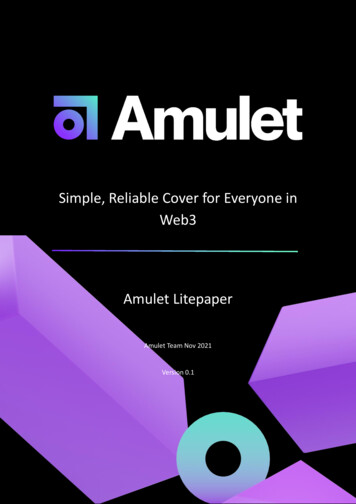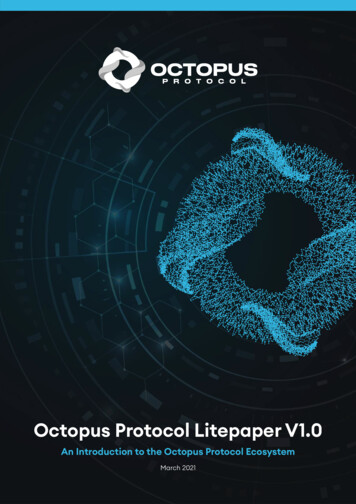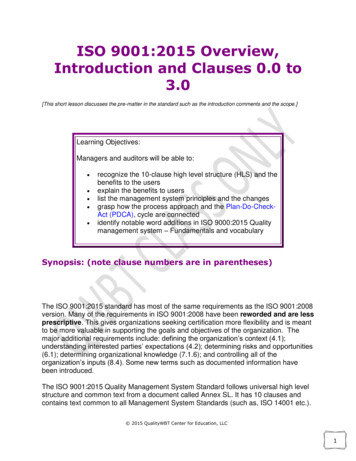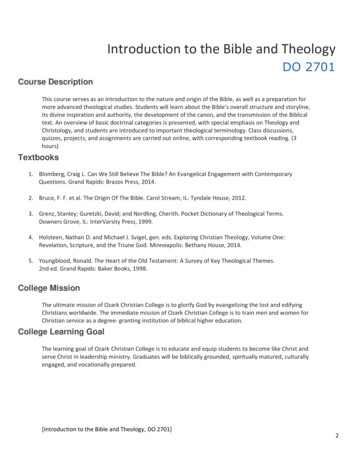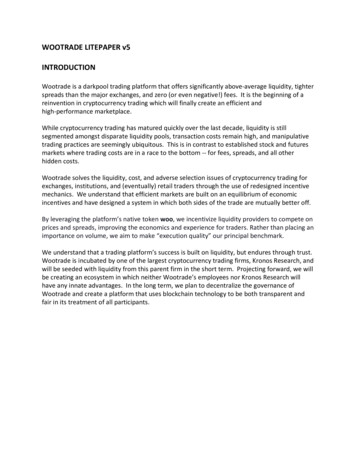
Transcription
WOOTRADE LITEPAPER v5INTRODUCTIONWootrade is a darkpool trading platform that offers significantly above-average liquidity, tighterspreads than the major exchanges, and zero (or even negative!) fees. It is the beginning of areinvention in cryptocurrency trading which will finally create an efficient andhigh-performance marketplace.While cryptocurrency trading has matured quickly over the last decade, liquidity is stillsegmented amongst disparate liquidity pools, transaction costs remain high, and manipulativetrading practices are seemingly ubiquitous. This is in contrast to established stock and futuresmarkets where trading costs are in a race to the bottom -- for fees, spreads, and all otherhidden costs.Wootrade solves the liquidity, cost, and adverse selection issues of cryptocurrency trading forexchanges, institutions, and (eventually) retail traders through the use of redesigned incentivemechanics. We understand that efficient markets are built on an equilibrium of economicincentives and have designed a system in which both sides of the trade are mutually better off.By leveraging the platform’s native token woo , we incentivize liquidity providers to compete onprices and spreads, improving the economics and experience for traders. Rather than placing animportance on volume, we aim to make “execution quality” our principal benchmark.We understand that a trading platform’s success is built on liquidity, but endures through trust.Wootrade is incubated by one of the largest cryptocurrency trading firms, Kronos Research, andwill be seeded with liquidity from this parent firm in the short term. Projecting forward, we willbe creating an ecosystem in which neither Wootrade’s employees nor Kronos Research willhave any innate advantages. In the long term, we plan to decentralize the governance ofWootrade and create a platform that uses blockchain technology to be both transparent andfair in its treatment of all participants.
OverviewWootrade Founded in June 2019 and completed seed funding with Hashkey Capital, FenbushiCapital, SNZ & DFund January 2020 - Fully functional darkpool servicing exchanges and institutional tradingclients via API August 2020 - Finished private sale and equity funding with Wootrade clients, globaltrading communities and top VCs including Dragonfly Capital and Three Arrows Capital. Now - for the BTC/USDT pair, WATS offers roughly 10 BTC of depth within 2 USD &100 BTC within 10 USD Now - 65,000 end users from B2B partners, executing roughly 4-5M USD per day atZERO Fees through WATS. 2021 target is 50-100M USD/day October 2020 - Zero Trading Fee Trading Platform with the flexibility & features activetraders craveFigure 1:
Kronos Research (initial liquidity provider to Wootrade) Founded June 2018Trading volume roughly 45 BILLION USD/monthFlagship fund 50% since inception March 2019 w 100% positive monthsDesignated Market Maker (DMM) for Binance, Huobi, OKEX and otherswoo is a native platform token which unites liquidity providers and seekers into a mutuallybeneficial economy that allows for zero-fee trading at the best execution prices globally.Traders, exchanges and those with asset management needs will directly benefit in a virtuousand self-reinforcing manner:Figure 2:
Background of ATS / Dark pools in Traditional FinanceWhile Wootrade is intended for the distinct challenges of cryptocurrency trading & investing, itis carefully modeled after the evolution of the world’s financial markets to ensure it has astrong business foundation. It is imperative to understand how both traditional andcryptocurrency markets operate to understand how Wootrade works and why it occupies anessential niche in the industry.Wootrade is a “dark pool” or Alternative Trading System (ATS), an oft-confused term thatmasks a very straightforward concept: a dark pool is like an exchange but one where traderscan interact privately, away from the eyes of the visible, or “lit”, exchanges.Dark pools are a necessary addition to trading infrastructure because being able to work withyour counterparty in private immensely improves pricing and liquidity. In fact, dark poolsrepresent a return to how humanity has transacted for most of human history – that is, untilthe computerization of exchanges—which is face to face, directly from one party to another.Markets participants quickly realized that the identity and reputation of your trading partneris actually an important trading signal in and of itself.For example, if a trader becomes renowned for their trading acumen—perhaps from oftenpossessing advanced knowledge of news and other events—then they would quickly find adearth of counterparties. Just like professional gamblers are shunned from amateur games,skilled traders would find that no one would want to trade with him at the same price aseveryone else. Offers would quickly adjust away in response to his bids.Conversely, if a counterparty is known to trade at her schedule without a correlation to futureprices, she would easily find a willing buyer for every posted sale. There may even be traderswilling to offer discounts in her favor.The defining property in this arrangement is the notion of toxicity. A counterparty’s orders –commonly referred to as order flow – is non-toxic if they have no predictive accuracy over acertain time period, commonly a short term one (i.e. two to thirty minutes). Investors whoare looking to hold an equity asset for months or years at a time are typically non-toxicbecause they are not looking to optimize what will happen in the minutes or hours after theirinvestment. Since most high-volume traders, like market makers, focus on short term returns,this means that investors’ flow is benign to trade against.In traditional markets, dark pools were instituted as a way for non-toxic traders to execute largetrades – called “block trades” for their size—in a way that would not impact the market price ofthe asset being traded. This works well for both the block trader and the market maker: the
block trader would avoid impacting the cost of a large trader, and the market maker couldobtain inventory for cheap. Since this is such a favorable trade for both parties, dark poolvolumes have steadily increased over the last two decades and now account for almost 65% ofall U.S. equity trading volume.Since the economics of executing with non-toxic order flow is very different from toxic flow,market makers are willing to heavily subsidize it. Retail order flow in particular is extremelynon-toxic and desirable for market makers. Often market makers will pay brokers for the rightto trade with their retail order flow in an arrangement called payment for order flow.Overview of Current Digital Asset Trading VenuesWhile the gap between trading services in cryptocurrency markets and traditional financialasset markets are closing, cryptocurrency markets must still resolve serious operational issues.The issues are compounded by the global reach that exchanges have and the lack of aconsistent global regulatory system. While certain countries have regulations in place that aredesigned to protect users from unscrupulous activity, exchanges are largely able to bypass thisby domiciling in a country with the most accommodating regulatory environment whilecontinuing to provide services to users based in the most stringent countries. Exploitativebehavior that would be curtailed by proper regulations remains rampant.Unlike traditional exchanges, cryptocurrency exchanges manage the entire trading businessvertical, which includes customer acquisition, fund custody, order matching and tradesettlement. This is an incredibly difficult challenge that is further amplified by the large numberof competitors. As such, the exchange business environment remains intensely cutthroat withthe average exchange lifespan lasting only a few years. Total trading volumes continue toremain the most important metric for exchanges because higher trading volumes attracttraders to trade on a platform. The push for higher trading volumes by exchanges has led to thecontinuous reporting of inflated trading volumes, which have been an issue among both largeand small exchanges. Unfortunately, when traders arrive on the platform, one cursory look atthe order books would make clear that the exchange’s volume and liquidity are faked. In theirefforts to boost total trading volumes, exchanges will also resort to offering higher risk productsthat go well beyond their execution capabilities to gain additional market share.Traders are also faced with platform instability caused by weaknesses in an exchange’s backendinfrastructure and connectivity. It is not uncommon for orders to fail to execute due to atechnical issue in the system. What makes the technical issues even more serious in crypto isthe severe volatility largely caused by the exchange’s very thin trading liquidity. A technicalissue in the middle of a huge price swing that prevents an order from executing properly canmean losses of staggering sums of money for both exchanges and traders.While traditional exchanges have seen a wave of consolidation over the last few decades, M&Aactivity among crypto exchanges remains low. The high fragmentation combined with the
minimal cooperation that occurs between exchanges results in constant asset mispricings. It isoften up to arbitrageurs to align prices even though they must assume significant exchangerisks associated with trading on all exchanges. The current situation also presents seriousissues for market makers as they are tasked with carrying the risk of arbitraging. Inaccurate orfraudulent price information further exacerbates these issues. These problems, however, canbe resolved immediately with proper regulation. In the US equity market for example,regulators have instituted the concept of a “national best bid & offer” (NBBO), ensuring thatorders need to be executed at the price of the best exchange, regardless of where it originated.These issues all collectively result in higher overall trading costs because it remains difficult forinvestors/traders to identify the best source of liquidity for a given asset. All of these issues alsosignificantly damage trader confidence, preventing larger-scale adoption amongst lesssophisticated retail customers. Most importantly is that this ultimately results in the highoverall risk profile of crypto, preventing wider institutional adoption and hindering crypto fromobtaining legitimacy as an asset class.There will be numerous beneficiaries from a strong Wootrade ecosystem. We summarize belowthe specific pain points we hope to solve for each of our initial target audience:Exchanges & trading platforms:1) Inability to attract professional market-makers and retail: Exchange liquidity is a classicchicken and egg problem. Without strong liquidity, traders won’t come and withouttraders, it’s hard to incentivize MMs to provide liquidity in the first place. Smallerexchanges use a variety of incentives to attract MMs but generally fail to achievetraction. It is difficult to know which MMs are reliable and even harder to motivate thetop MMs to fully support the exchange. Therefore, it is generally not economical forestablished MMs to spend time and human capital to connect to a new or smallexchange2) Lack of differentiating products: In an ultra-competitive environment, a unique offeringfor clients is essential. However, these exchanges have enough trouble providing thebasic necessities such as a good trading interface, stability and liquidity. They do nothave the experience nor resources to launch, maintain and improve unique andattractive financial productsLarge traders/OTC desks1) High slippage/execution costs: Price-conscious retail and all institutions are activelylooking for more efficient ways to gain and offload exposures quickly at the lowestpossible slippage. Being able to execute large orders at superior prices via ATS’s awayfrom the public exchanges is a crucial need
2) Trading GUI/Interface: Professional traders and investors demand robust andcustomizable execution systems complete with algorithms to help decrease slippageand increase profitsWootrade’s suite of solutions will dramatically transform the rules of the game and seek toresoundingly put these issues to rest.Figure 3: Cost Benefit comparison of using Wootrade vs leading exchangesAssumptions:1) traders pay average of Binance and Huobi spot fees based on volume traded2) traders hold relevant platform tokens to reduce trading feesWootrade ATS {The Liquidity Standard}WATS is an Alternative Trading System with backing from Kronos Research, a top cryptoquantitative fund that currently trades roughly 45 billion per month and is a leading liquidityprovider on the largest digital assets exchanges. Kronos Research can use its expertise in priceprediction, risk handling, and inventory management to uniquely bootstrap Wootrade’s orderbook size and depth of WATS. Combining this with Wootrade’s unique system of incentivizingexecution quality results in a pool of liquidity that is superior to the liquidity provided by thecumulative order books of established exchanges.
While cryptocurrency trading has significantly improved its level of services and order executionquality in a few short years, it remains well behind the standard level in traditional financialmarkets. In equities markets, traders that trade through a dark pool are charged zerotransaction fees, experience minimal slippage, and have access to an order book depth and athin bid-ask spread that is often better than traditional exchanges.The WATS dark pool is designed to provide crypto traders with the same level of benefits. Thesmaller exchanges, which still collectively handle a significant portion of trading volume, arestuck trying to simultaneously build out their internal market-making systems while attracting acore user base. With Wootrade, the smaller exchanges now have the option of delegating themarket making duties to the WATS platform and focus entirely on what they do best. Smallerexchanges can turn to Wootrade for full order book support or just to use as a hedging venue.WATS encourages high-quality liquidity through the use of pricing segmentation. Instead ofone order book for all participants like in a public exchange, each type of LFP will actually haveits own dark pool and order book. This ensures that MMs can price the risk coming from theorder flows of a particular LFP correctly. Less toxic LFPs will be highly sought after, and willreceive very competitive quotes; toxic LFPs will be offered quotes which are consistent withexternal exchanges and no better.Figure 4: ATSMarket participants can accessWootrade directly via websocket/RESTAPIs, via one of our certified vendorpartners or through our ultra-intuitiveuser interface.Through the value that Wootradecreates for its core users, we areconfident that the platform willbecome an important part of crypto’strading infrastructure and also play acentral role in crypto’s advancementas an asset class.
WATS Business ModelWATS is structured to incentivize participation from two groups of traders: Liquidity Flow providers (LFPs) who possess order flow that they wish to execute. LFPsare typically exchanges, wallets, or proprietary trading teams. LFPs care most aboutexecuting their trades at the best average price possible, the measure of which iscalled execution quality Market makers (MMs) who look to be a ready buyer for every seller, and a ready sellerfor every buyer. Market makers aim to make small profits on a large volume of tradesby providing liquidity. Staking - those who wish to provide more liquidity to the system may do so via stakingmechanisms. Participants simply choose which token they wish to stake and will berewarded in that token depending on a number of factors.In traditional U.S. equity markets, established LFPs will direct their order flows to large MMs inreturn for execution quality. These market making firms will offer deep liquidity and muchbetter prices than what LFPs can get on the open market – and often with no fees. However,there is a downside: due to a combination of strict regulations and significant customeracquisition costs, it can be difficult for new LFPs or MMs to get started.Figure 5: Revenue SourcesWATS is designed to mimic and improve upon the tested paradigm of traditional markets, butin a way that prioritizes the concepts of critical mass and network effects. The success of theWootrade ecosystem is dependent on gaining a critical mass of users, service providers andeventually developers to achieve a self-sustaining cycle of growth and innovation. As we haveseen with many of the trading platforms created over the past few years, there exists aso-called ‘chicken-and-egg’ problem where traders refuse to commit to a platform without
sufficient liquidity and yet liquidity providers refuse to commit their time to a platformwithout users. To resolve this issue, Wootrade has the backing of Kronos Research which has avested interest and the ability to ensure that the liquidity and trading fees are the mostcompetitive in the world.So to achieve critical mass, Wootrade must allocate resources in a more centralized mannerand experiment flexibly with a variety of incentive dynamics that would not be possible in adecentralized manner. What ultimately separates platforms with critical mass from others isthe network effects created by the platform. In the case of multi-sided platforms such asWootrade, both direct and cross-side network effects are important to consider. Directnetwork effect for example is a networking platform like Instagram which becomes morevaluable as more of the same type of users join. Cross-side network effects would be likeLinkedIn in which more benefit is derived when those searching for employment and thosesearching for talent both increase.a) Direct network effect - more traders/end users results in more two-way flow which byitself would create more efficient markets for the end-usersb) Cross-network effect - there are a couple of these embedded in our design, but themost obvious would involve liquidity flow providers (LFPs) and liquidity providers(MMs). the more flow that is driven to the platform, the more attractive participationbecomes for MMs.Another dynamic to consider here is that WATS is free and open to all flow providers such asOTC desks, exchanges and traders to use. Third-party platforms/exchanges can achievesuperior liquidity just by connecting to WATS and their ability to utilize this advantage to gainmore customers will magnify the network effects of Wootrade. We have partnered with bothcentralized and decentralized exchanges in this regard. In summary, the platform creator mustsubsidize at least one side of the market to have a chance at achieving critical-mass adoption.
Figure 6: Network effect flywheelFor the main participants of the ecosystem to continuously iterate towards the desired actionsand results, we introduce our native currency called woo . The token in our view is actually apowerful network magnifier to attract and retain key participants and to guide desiredbehavior. The classic use case of WOO is similar to other platform tokens - from collateral tofee-reduction/rebate mechanisms.At its simplest, the token must help to maximize non-toxic flow while minimizing toxic flowand at the same time maximize liquidity.More novel use cases involve staking into market-making pools that utilize Kronos Research’sability in trading, governance functions, targeted reward mechanisms for contributors to theplatform - such as rewarding flow providers (nodes) with tokens. More details below on ourtoken use cases.Plan for the future: a self-sustainable & more decentralized ecosystemThe strength of blockchain is in decentralization, and Wootrade is not foreign to this vision.For example, Wootrade’s ability to attract and work with leading market makers can providemany unique opportunities that other competing decentralized networks cannot.One proposed idea is to improve the ability of market makers by allowing them to utilizedecentralized price prediction oracles supplied by existing trading experts. These pricepredictions are usually the result of sophisticated models generated by sophisticatedquantitative researchers for use in their own trading strategies. In fostering a decentralizedwoo-token powered economy around the publishing and subscription of price predictions,
researchers can profit from allowing others to subscribe to their predictions, and marketmakers can adjust their quotes more quickly to changing markets.Further, we plan to eventually launch Wootrade into a platform that is free from anycentralized point of failure. This includes technological deficiencies like hardware issues, powergrid failures, or DDOS attacks. It also includes regulatory risk from specific jurisdictions makingdecisions on what can be traded and by whom. Ultimately, we believe that the power andfreedom of trading should lie with traders.The details of this approach will be circulated in the future, but the highlights are as follows:a) There are three parties in this system: traders, routing agents, and matching enginenodes. Wootrade will be circulated as a piece of software which will allow these partiesto interact with each other.b) Traders will be able to send messages to matching engine nodes by encrypting theirmessages and passing them to routing nodes. Each message will contain the address ofone or more routing nodes, and the payload is encrypted multiple times by the publickey of each routing node in a TOR-like algorithm. Each routing node will know wherethe message is being directed to, but not its final destination nor its original sender.c) Matching engines will take turns handling the matching for a variety of “symbols”, butwill not know what symbol it is matching until after the matching is complete. Tradingwill transition to a type of trading that has better periodic auction-style mechanismd) The platform payment detailed at the bottom of section 2.a. will go to a new party, the“matching engine” node. The matching engine node is tasked with matching ordersfrom traders.Governance & the woo tokenBelow is a short discussion of Wootrade’s governance system. The system, it’s parameters andrules are subject to change.One of the most exciting things about working in the blockchain industry is the ability toexperiment with novel business, economic and management models. There have been manyattempts in the past at decentralizing exchanges and protocol governance, but significantimprovements can be made. Up to now, governance models in crypto resemble naïvedemocratic systems that have proven to be ineffective at best and disastrous at worst. Combinethis with the need for an autonomous and decentralized tech stack that is supposed to endurethe test of time and you end up with unmet expectations.To achieve an ecosystem that is widely adopted, useful, and permanent, governance cannotremain centralized. However, if we decentralize too fast, there could be serious consequences.We’ve seen a few high profile defi projects get gamed and lose significant value due to evenslight oversights in incentive mechanisms or issues with smart contract code.
Therefore, a Governing Council carefully selected from core team members, shareholders,community participants and business partners will be managing the ecosystem using anoff-chain governance model initially likely involving TCR. We will decentralize gradually withhigh probability adjustments one at a time and only after careful simulations andexperimentation at a smaller scale.In this off-chain governance model, participants communicate outside of the Wootradenetwork. The main functions of governance participants will be to create proposals orchallenges and vote on them. Proposals can be created by any member, but only the proposalswith sufficient points are then discussed and voted upon.Only woo tokens can be staked to earn voting points – based on amount and duration staked that the staker can then use to vote on proposals. The points are not tokenized by Wootrade soat least initially, they cannot be transferred, bought or sold.The process to add new members to WATS could also involve voting. If an exchange would liketo use WATS, they would apply by depositing tokens which would open a “registrationwindow.” If there’s no challenge during this time period, then they are approved and thetokens would be distributed amongst the nodes. Others may challenge the new entrant by alsodepositing tokens. If the community votes for the challenger, then the applicant’s tokens aretaken and given to the challenger. If the challenger loses, then their tokens would bedistributed to the nodes. This is just one example of many governance use cases once we areready to hand over operations to the community.woo tokens enable more decentralized and transparent governance which should increaseinclusion from all participants large and small. Anyone can participate in creating proposals andplay a key role in the evolution of the ecosystem. Some of the initial decision-making aspectsopen to proposals and voting include:* minimum staking amount for node application* minimum and maximum duration for staking* voting points accrual mechanism* product or token development listings & features* fee models/rebates/revenue waterfall (value capture voting)* token distribution rates and dynamics based on various forms of miningThese basic but important governance functions will provide our partners, investors andcommunity unprecedented ability to help shape and evolve Wootrade continuously.The woo token unifies participants of Wootrade into self-reinforcing network
The Wootrade native token, woo , has a cap set at 3,000,000,000 tokens. 20% of the tokens aresold in the private and public sales. 20% are team tokens and 5% are advisor tokens, both ofwhich are locked for 4 years. 50% of tokens are ecosystem tokens earmarked for various mining/ staking rewards. The remaining 5% is for liquidity management.Certain factors will determine the initial reward rates which are inversely correlated with thepercentage of tokens staked. Initially determined by the Governing Council, this rate may bechanged by community vote in the future.The woo Token serves the following four critical functions on the platform:Collateral : woo may be used as trading collateralMining : Earn woo for bringing quality order flow to the platform as a nodeStaking : Stake w oo in market-making fund or to accrue voting pointsPayment : Pay less in margin and wealth management fees with wooUse, stake, vote - these are done differently on Wootrade. With these slight but importantadjustments, we should be able to find a good balance between those who want to stake andthose who want to use w oo tokens inside the ecosystem. A few crucial tenets the token isbuilt on are below:1) duration matters - should those who are more loyal to the platform be rewarded morethan those who are more transient in their contributions? We believe so and will beaccruing voting points and w oo rewards faster to those who hold for longer periods oftime2) governance/voting record - we will actively design mechanisms that rewards those whoconsistently make optimal decisions or submit novel and valuable proposals with moreinfluence and tokens3) dynamic equilibrium - mining reward rates for staking, flow and even trading fees shallbe adjusted dynamically. If only a small percentage of tokens are staked, then thereward rates shall be higher and will decrease as more tokens are staked. Similarly,rebate rate for flow will increase if flow quality is high and demand for this flow isincreasingWe believe that by adopting decentralization gradually will give the greatest flexibility whilegiving the highest probability of achieving the eventual goal of a self-sufficient system whichstandardizes liquidity and provides for inclusive wealth management.In this paper, we have discussed the background of the parallel traditional financial markets andwhy Wootrade exists - specifically addressing the most pressing issues in digital asset tradingand investing. On its own, Wootrade will set the standard for crypto liquidity and investing, but
tied with the woo token, we introduce important use cases of governance, revenue sharing,mining and staking mechanisms which should increase platform adoption rates and inclusion.Figure 7: WOO Rewards & Buyback Pool EstimationWootrade Daily Volume 0,000450,000WOO Reward Pool in WOO Tokens281,250,000112,500,00022,500,000Flow Rewards (75% of Pool) in WOO Tokens210,937,50084,375,00016,875,000Staking Rewards (25% of Pool) in WOO Tokens70,312,50028,125,0005,625,000WOO Buyback Pool (50% of Total Rev) USD11,250,0004,500,000900,000Annual WOO Buyback # of .00%Annualized WOO Token Reward Pool (USD)Annual WOO Buyback %age of CirculatingEvery single token holder can-- and we hope, will -- contribute to the evolution of Wootrade.This is the ambitious timeline we are executing against and we hope you will join us on thisexciting journey.Timeline:July 2019Wootrade ATS (WATS) founded & seed round completedDecember 2019WATS 1.0 launches for initial clientsJune 2020CTO onboarded 2 senior backend engineersJuly 2020WATS 2.0 replaces WATS 1.0 - higher scalability & reliabilityAugust 2020Private sale and equity round completedSeptember 2020Leveraged spot trading, Woo.trade new website launch
October/November 2020Token sale/Token GenesisToken use cases live for WATSQ1 2021Trading platform launchQ2 2021Futures trading launchQ3 2021Decentralized Wealth Management Platform LaunchSeries A Funding2022Decentralized operations / ownership phase
The push for higher trading volumes by exchanges has led to the continuous reporting of inflated trading volumes, which have been an issue among both large and small exchanges. Unfortunately, when traders arrive on the platform, one cursory look at the order books would make clear that the exchange's volume and liquidity are faked. In their
